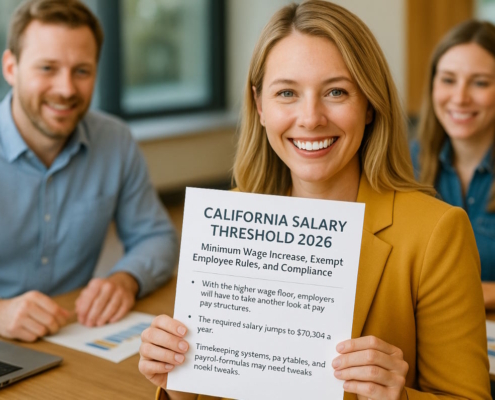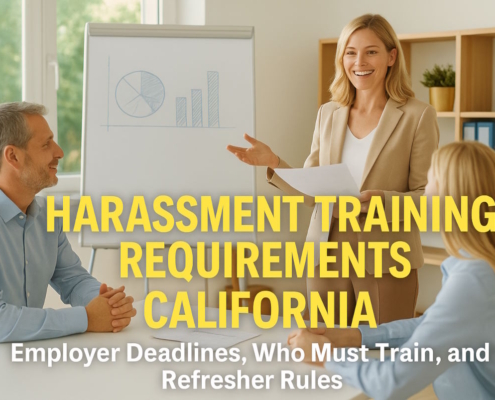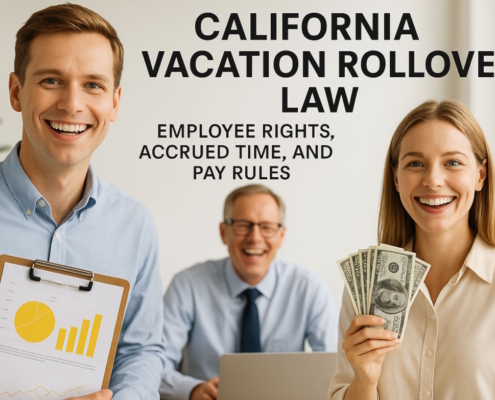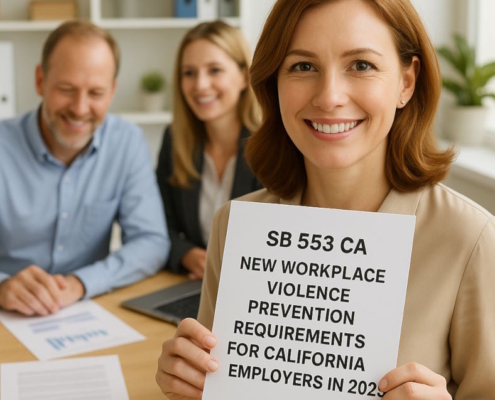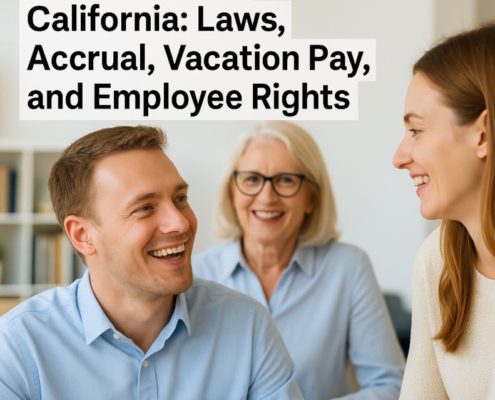What is age discrimination in the workplace? (Examples)
Age discrimination involves treating an applicant or employee less favorably because of his or her age. The Age Discrimination in Employment Act (ADEA) forbids age discrimination against people who are age 40 or older.
By Douglas Wade, Attorney
Email | Call (800) 484-4610
Get Smarter. Search FAQs.
The Age Discrimination in Employment Act (ADEA) is a federal law that prohibits U.S. employers from discriminating against employees who are 40 years old or older based on age. Age discrimination is illegal during any part of the employment process, from hiring to firing and every step in between. According to a AARP poll in 2022, a staggering two-thirds of individuals aged 45 and above have experienced or witnessed age discrimination in the workplace. These findings shed light on a pervasive issue that affects not only individuals in the latter stages of their careers but also society as a whole.
Age discrimination may be defined as the unfair treatment or prejudice faced by individuals based on their age, particularly when it negatively affects their ability to obtain or maintain employment. This discriminatory practice is not only ethically wrong but also has significant implications for both employees and employers.
One key aspect of age discrimination is the devaluation of the skills, knowledge, and experience that older workers bring to the table. Despite their years of expertise and accumulated wisdom, older individuals often find themselves marginalized and overlooked in favor of younger counterparts. This not only deprives organizations of valuable contributions but also perpetuates a culture of underutilization and missed opportunities.
Moreover, age discrimination can hinder career progression for older employees, impeding their chances of securing promotions, training opportunities, or even new employment altogether. This not only impacts their financial security and professional growth but also contributes to a diminished sense of self-worth and overall well-being.
Recognizing the significance of this issue, it is crucial for employers seek consultation with an employment attorney for employers who specializes in age discrimination cases can provide invaluable guidance and support.
In this article, our small business attorney in Los Angeles discusses six common examples of age discrimination in the workplace.
-
Disproportionate hiring of younger people
One particularly glaring example of age discrimination in the workplace is the disproportionate hiring of younger employees or the practice of hiring solely based on youth. This discriminatory hiring practice manifests when employers prioritize candidates solely based on their age, often favoring younger individuals while overlooking the qualifications and experience of older applicants.
This discriminatory approach can stem from various misconceptions and stereotypes associated with different age groups. Some employers may perceive younger candidates as more tech-savvy, adaptable to change, and possessing fresh ideas. However, these assumptions overlook the wealth of experience, expertise, and stability that older candidates can bring to a company.
The consequences of disproportionate hiring of younger employees based on age are far-reaching. Firstly, it perpetuates the marginalization of older workers who may face increased difficulty in finding suitable employment opportunities. Despite possessing the necessary skills and qualifications, they may find themselves overlooked due to age-related biases. This not only hinders their career prospects but also robs organizations of valuable talent and diversity of thought.
Further, this discriminatory hiring practice contributes to the creation of age-segregated work environments, where intergenerational collaboration and knowledge sharing are undermined. A workforce that lacks age diversity can lead to a lack of representation and understanding of different perspectives, hindering innovation and productivity.
It is essential to recognize that age should not be a determining factor in assessing an individual’s ability to contribute to the workplace. Competency, qualifications, skills, and experience should be the primary criteria for hiring decisions. Embracing age diversity in the workforce can foster an inclusive environment that harnesses the strengths of individuals at different stages of their careers.
To combat this form of age discrimination, it is crucial for businesses to implement fair and unbiased hiring practices. They should focus on evaluating candidates based on their qualifications, experience, and potential, rather than relying solely on age-related assumptions. Additionally, creating policies and training programs that promote diversity and inclusion can help mitigate age discrimination and foster an inclusive work environment.
-
Few opportunities for advancement
Another prevalent form of age discrimination in the workplace is the limited opportunity for advancement experienced by older workers. Despite their wealth of knowledge, experience, and dedication, older employees often find themselves facing barriers when it comes to career progression within their organizations.
Several factors contribute to this discriminatory practice. One key factor is the perception that older workers are less adaptable to change or lack the necessary technological skills required in modern workplaces. This stereotype overlooks the fact that older employees can possess a deep understanding of industry trends, extensive networks, and refined problem-solving abilities acquired through years of experience.
Another factor is the misguided assumption that older employees are nearing retirement and may not be committed to long-term career goals. This biased perception can lead employers to overlook their potential for growth and deny them opportunities for advancement, such as promotions, challenging assignments, or leadership roles.
The consequences of limited advancement opportunities for older workers are far-reaching. Firstly, it harms their professional growth and the opportunity to utilize their full potential. This not only affects their job satisfaction but also impacts their financial security and overall well-being. Additionally, it creates a sense of disengagement and demotivation, leading to decreased productivity and employee morale.
The lack of advancement opportunities for older workers perpetuates a culture of ageism within organizations. It sends a message that age determines one’s worth and potential, rather than individual skills, qualifications, and performance. This can lead to the creation of age-segregated workplaces, which has a negative impact on collaboration, diversity, and the exchange of ideas between different generations.
To address this form of age discrimination, companies must actively promote equal opportunities for career advancement. They should evaluate employees based on their skills, performance, and potential, rather than age-related assumptions. Implementing transparent and merit-based promotion processes, providing mentorship programs, and offering training opportunities can help bridge the advancement gap for older workers.
Fostering a culture of inclusivity and appreciation for diverse perspectives is crucial. Encouraging intergenerational collaboration, knowledge sharing, and recognizing the value of experience can contribute to a more vibrant and productive work environment.
-
More likely to be laid off or fired
One distressing form of age discrimination in the workplace is the targeted selection of older workers for layoffs or staff reduction. When companies face financial challenges or restructuring, some employers may unjustly focus their cost-cutting measures on employees who are older, often based on assumptions about their perceived higher salaries, healthcare costs, or proximity to retirement.
This discriminatory practice is detrimental on multiple levels. Firstly, it unjustly affects older workers who have dedicated years of service to their organizations and have valuable skills and expertise to offer. By targeting them solely based on age, employers disregard their contributions and undermine their job security, leading to financial instability and emotional distress.
Moreover, targeting older workers during layoffs perpetuates the notion that their age determines their value and employability, rather than their qualifications, performance, or potential. This reinforces age-related stereotypes and further marginalizes older employees, creating an environment where age discrimination is tolerated and perpetuated.
The consequences of targeting older workers during staff reductions extend beyond the individuals affected. It erodes trust and morale among the remaining workforce, leading to increased job insecurity and decreased loyalty towards the company. It also reduces intergenerational collaboration and knowledge transfer, as businesses lose the opportunity to benefit from the experience and mentorship older workers can provide to younger colleagues.
To address this form of age discrimination, companies must prioritize fair and equitable practices during staff reductions. This includes evaluating employees based on their skills, performance, and overall contributions, rather than relying on age-related assumptions. Implementing objective criteria and transparent processes for determining layoffs can help mitigate the impact of age discrimination and ensure that decisions are based on legitimate business needs.
Businesses should invest in training programs that promote age diversity and inclusion. By fostering a culture that values the contributions of employees at all stages of their careers, organizations can harness the collective wisdom and experience of their workforce, leading to increased innovation and productivity.
-
Isolation
Age discrimination in the workplace can also manifest in the form of isolating older employees, creating a hostile and exclusionary environment that marginalizes and alienates them. This type of discrimination occurs when employers or colleagues deliberately exclude or segregate older workers, denying them the same level of participation, collaboration, and opportunities for growth as their younger counterparts.
Isolation of older employees can take various forms. It may involve excluding them from decision-making processes, team projects, or social gatherings, or even isolating them physically by assigning them to separate workspaces or limiting their interactions with colleagues. These actions convey a message of devaluation, making older employees feel undervalued, unappreciated, and disconnected from the workplace community.
The consequences of isolating older employees are significant and detrimental. It creates a hostile work environment that erodes employee morale, job satisfaction, and overall well-being. The feeling of exclusion can lead to decreased productivity, increased stress, and a sense of disengagement from work. Additionally, it can perpetuate stereotypes and biases, reinforcing age-related prejudices and hindering the potential for intergenerational collaboration and knowledge sharing.
Furthermore, isolating older employees results in a loss of valuable expertise and institutional knowledge that they have accumulated over their careers. By failing to include them in decision-making processes or team projects, companies miss out on the diverse perspectives, problem-solving abilities, and innovative ideas that older employees can bring to the table.
To address this form of age discrimination, companies should foster an inclusive culture that values employees of all ages. This starts with leadership setting a positive example by promoting collaboration, respect, and appreciation for the contributions of all individuals. Encouraging intergenerational mentorship, team-building activities, and inclusive communication channels can help bridge the gap and create a sense of belonging for older employees.
Training programs on diversity, inclusion, and unconscious bias can also raise awareness and educate employees about the damaging effects of age discrimination and the importance of fostering an inclusive work environment. By addressing age-related stereotypes and biases, companies can work towards eliminating the isolation experienced by older employees.
It is crucial for management to lead by example and actively promote opportunities for intergenerational collaboration. Encouraging cross-generational teamwork, mentoring programs, and knowledge-sharing initiatives can create a vibrant and productive work environment that benefits from the diverse perspectives and experiences of all employees.
-
Age-based harassment
Age discrimination in the workplace can take the form of age-based workplace harassment, where employees are subjected to offensive or derogatory behavior based on their age. This type of discrimination creates a hostile work environment and can have severe negative impacts on the targeted individuals’ well-being, job satisfaction, and overall professional experience.
Age-based workplace harassment can occur in various ways. It may involve derogatory comments or jokes about an individual’s age, belittling their abilities or competence based on stereotypes, or exclusion from work-related activities due to their age. Such behavior can come from colleagues, supervisors, or even subordinates, perpetuating age-related biases and creating a toxic atmosphere that undermines productivity and job performance.
The consequences of age-based workplace harassment are significant and far-reaching. Targeted individuals may experience increased stress, anxiety, and a decline in self-confidence, leading to decreased job satisfaction and motivation. It can also negatively impact their professional growth and career opportunities, as the hostile environment may limit their ability to showcase their skills or receive fair consideration for promotions or other advancements.
Age-based workplace harassment is also dangerous to a business in that it erodes employee morale and team cohesion. When individuals are subjected to derogatory comments or exclusion based on their age, it creates a divisive atmosphere and impedes effective collaboration. This not only harms the targeted individuals but also affects the overall productivity and effectiveness of the entire team.
To combat age-based workplace harassment, companies must prioritize creating a culture of respect, inclusivity, and zero tolerance for any form of discrimination. This starts with clear policies against age-based harassment and regular training sessions that raise awareness about the issue and educate employees on appropriate behavior in the workplace.
Employers should encourage an open and supportive environment where employees feel safe to report incidents of age-based harassment without fear of retaliation. Implementing robust reporting mechanisms and conducting thorough investigations when complaints arise is crucial for addressing the issue promptly and ensuring appropriate consequences for the harassers.
Companies should foster a culture of diversity and inclusion, celebrating the contributions and experiences of employees of all ages. Encouraging intergenerational mentorship and creating opportunities for age-diverse teams to collaborate can help break down age-related barriers and promote mutual respect among colleagues.
Legislation also plays a critical role in combating age-based workplace harassment. Employers should be aware of their legal obligations and take proactive steps to prevent and address age-based harassment within their companies.
-
Unfair disciplinary action
Finally, age discrimination can manifest in the form of unfair or unreasonable disciplinary action targeted at older employees. This type of discrimination occurs when employers subject older workers to disproportionate or unjust disciplinary measures solely based on their age, without valid justification or objective assessment of their performance.
Unfair or unreasonable disciplinary action based on age can take various forms. It may involve issuing harsher penalties, stricter monitoring, or more frequent performance evaluations for older employees compared to their younger counterparts. Additionally, older workers may be held to different standards or subjected to stricter scrutiny, creating an environment where their mistakes or shortcomings are disproportionately magnified or punished.
The consequences of such discriminatory disciplinary actions are detrimental to the targeted individuals and the overall work environment. Firstly, it undermines the older employees’ sense of fairness and can lead to feelings of frustration, demoralization, and a decline in job satisfaction. Unjust disciplinary measures can also erode trust and loyalty, damaging the employment relationship and creating a toxic work environment.
Unfair or unreasonable disciplinary action based on age perpetuates stereotypes and biases that older workers are less capable, adaptable, or competent compared to their younger counterparts. This discriminatory practice fails to recognize the valuable skills, experience, and expertise older employees bring to the table. It also inhibits the ability of older workers to contribute fully, hindering their professional growth and stifling the potential benefits they can offer to the company.
To address this form of age discrimination, organizations must establish fair and transparent disciplinary policies and procedures that apply to all employees, regardless of age. These policies should be based on objective performance criteria and clearly communicated to all staff members. Managers and supervisors should receive training on avoiding age-related biases and assessing employee performance objectively.
It is crucial for older employees who believe they have been subjected to unfair or unreasonable disciplinary action based on age to seek appropriate recourse. This may involve raising concerns with human resources, filing complaints through internal channels, or consulting legal professionals experienced in employment law to explore their options.
Have a quick question? We answered nearly 2000 FAQs.
See all blogs: Business | Corporate | Employment
Most recent blogs:






